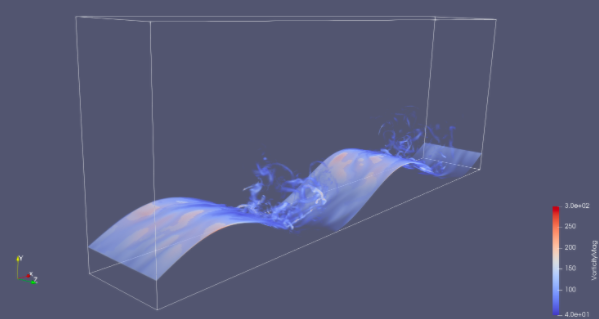Visualising ripple effects in riverbed sediment transport
The Challenge:
Understanding the complex physical relationship between a flowing current and a sediment bed in marine systems like rivers and channels.The Solution:
A Consultancy project with NeSI research software engineers, who introduced visualization tools with ParaView and access to Māui and Mahuika supercomputers to simulate flowing current and view it through multiple filters.The Outcome:
A morphodynamic model that can better predict sediment transport and seabed evolution.
The flow of a body of water depends on how the sediment on the floor and the water current interact as it flows. Small ripples in the sand of a riverbed can create little waves, while large dunes beneath the water can cause eddies that affect the river flow. Knowing how a water body changes in response to its bedform shape is an important question in many forms of engineering, as well as in environmental science, and even in uncovering the history of ancient water bodies through sediment deposits on Earth and Mars.
Doctoral candidate, Chuang Jin and Professor Giovanni Coco used NeSI supercomputers to create a visualisation of bedform morphodynamics – how water and bedforms interact. Giovanni and Chuang had gathered experimental data from bedforms in New Zealand and wanted to create a visual simulation of how fluids flowed around these bedforms.
“We’re now working on the paper. The project mainly involved three-dimensional visualisation and interpretation of our experimental data and numerical results. NeSI team members were able to help me learn ParaView to build the visualisations,” Chuang said.
ParaView visualisation software allowed Chuang and Giovanni to view the flow as moving surfaces, directional arrows, and mesh lines. The high resolution of their model required them to use NeSI’s HPC platform for computing these data-rich visualisations.
The interaction of water and bedforms involves complex physics. There is constant variation in the water flow as it hits the uneven sediment floor of the bedform. This can be affected not only by the shape of the ripples and dunes of the bedform, but also the type of sediment – whether sand or pebbles – that the water interacts with. The bedform is also constantly changing, as the water flow moves sediment from one place to another. For this reason, being able to simulate the bedform flow requires access to a large number of computer cores. Chuang and Giovanni turned to NeSI for use of the Māui and Mahuika supercomputers.
“This model required over 1,000 cores to run. In the beginning, we were using Mahuika to try and run this, but only had access to a relatively small number of cores. It made it take a long time to process, so we then made the move over to Māui,” Chuang said. “NeSI helped us with that transition and solved the problems we had once we were on Māui.”
In addition to supporting the researchers with building, running, and visualising their model, this Consultancy project also investigated different ways of numerically computing vorticity with optimal accuracy. Vorticity is a fundamental quantity in fluid dynamics that describes the spinning motion of eddies in a flow.
“NeSI provided critical help at a critical time," said Giovanni. "It was great to see how they engaged with the problems we were having. We had several online meetings and it was exciting to see the feedback between us explaining the physical processes and NeSI staff providing all sorts of ideas and suggestions. Our work is important in the fields of geology, geomorphology, coastal and environmental engineering. Knowledge of sediment transport is most often used to determine whether erosion or deposition will occur, and its magnitude and variability. Sediment transport is also critical in providing habitat for fish and other organisms in rivers and coastal waters.”
Visualisation tools are a powerful way to represent experimental data, making it easier to understand and providing new insights into the natural world. When studying complex physical relationships like bedform morphodynamics, NeSI’s HPC platform enables researchers to leverage visualisation tools like ParaView to gain better and more in-depth insights of challenging research questions.
Do you have an example of how NeSI platforms have supported your work? We’re always looking for projects to feature as a case study. Get in touch by emailing support@nesi.org.nz.







